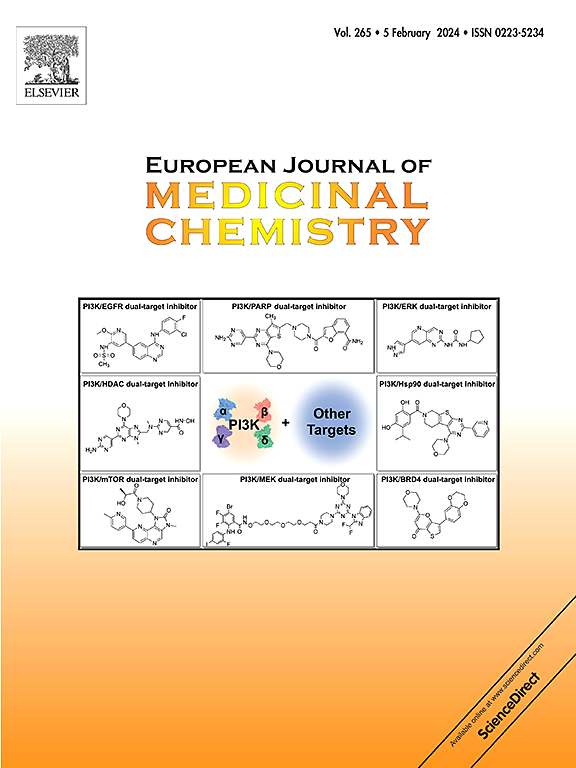膜活性大麻色素衍生物的设计、合成和生物学评价
IF 5.9
2区 医学
Q1 CHEMISTRY, MEDICINAL
引用次数: 0
摘要
多药耐药(MDR)细菌感染的日益流行强调了迫切需要具有不同机制的新型抗菌药物。在这项研究中,我们提出了合理的设计和合成阳离子两亲性大麻色素(CBC, 1)衍生物,模拟抗菌肽(AMPs)。通过季铵离子的掺入优化CBC的结构,提高了其亲水性,扩大了抗菌谱。在35个化合物中,化合物11F对革兰氏阳性病原菌(MIC = 0.25 ~ 0.5 μg/mL)和革兰氏阴性病原菌(MIC = 0.5 ~ 8 μg/mL)均表现出较强的抗氧化活性,优于万古霉素和头孢他啶。机制研究表明,11F通过与磷脂酰甘油(PG)的高亲和力结合破坏细菌膜,导致膜渗透和细胞质渗漏。分子动力学模拟支持其膜靶向机制,由两亲性插入脂质双分子层驱动。活性氧(ROS)的协同积累进一步增强了杀菌作用。化合物11F具有低溶血和细胞毒性,在小鼠MRSA脓毒症模型中显示出体内有效性(10 mg/kg时细菌减少98.8%),具有良好的安全性。本研究确定了化合物11F作为一种有前途的膜活性抗菌剂,具有转化为临床抗耐多药感染的潜力。本文章由计算机程序翻译,如有差异,请以英文原文为准。


Design, synthesis, and biological evaluation of membrane-active cannabichromene derivatives as potent antibacterial agents
The increasing prevalence of multidrug-resistant (MDR) bacterial infections underscores the urgent need for novel antimicrobial agents with distinct mechanisms. In this study, we present the rational design and synthesis of cationic amphiphilic cannabichromene (CBC, 1) derivatives that mimic antimicrobial peptides (AMPs). Structural optimization of CBC through the incorporation of quaternary ammonium cations improved hydrophilicity and expanded the antibacterial spectrum. Among the 35 derivatives, compound 11F emerged as the lead candidate, exhibiting potent activity against Gram-positive (MIC = 0.25–0.5 μg/mL) and Gram-negative pathogens (MIC = 0.5–8 μg/mL), surpassing vancomycin and ceftazidime in efficacy. Mechanistic studies revealed that 11F disrupts bacterial membranes through high-affinity binding to phosphatidylglycerol (PG), resulting in membrane permeabilization and cytoplasmic leakage. Molecular dynamics simulations supported its membrane-targeting mechanism, driven by amphiphilic insertion into lipid bilayers. The synergistic accumulation of reactive oxygen species (ROS) further amplified the bactericidal effects. Compound 11F demonstrated low hemolysis and cytotoxicity, showing in vivo efficacy in a murine MRSA sepsis model (98.8 % bacterial reduction at 10 mg/kg) and displaying excellent safety. This study establishes compound 11F as a promising membrane-active antibacterial agent with potential for translation into clinical use against MDR infections.
求助全文
通过发布文献求助,成功后即可免费获取论文全文。
去求助
来源期刊
CiteScore
11.70
自引率
9.00%
发文量
863
审稿时长
29 days
期刊介绍:
The European Journal of Medicinal Chemistry is a global journal that publishes studies on all aspects of medicinal chemistry. It provides a medium for publication of original papers and also welcomes critical review papers.
A typical paper would report on the organic synthesis, characterization and pharmacological evaluation of compounds. Other topics of interest are drug design, QSAR, molecular modeling, drug-receptor interactions, molecular aspects of drug metabolism, prodrug synthesis and drug targeting. The journal expects manuscripts to present the rational for a study, provide insight into the design of compounds or understanding of mechanism, or clarify the targets.

 求助内容:
求助内容: 应助结果提醒方式:
应助结果提醒方式:


